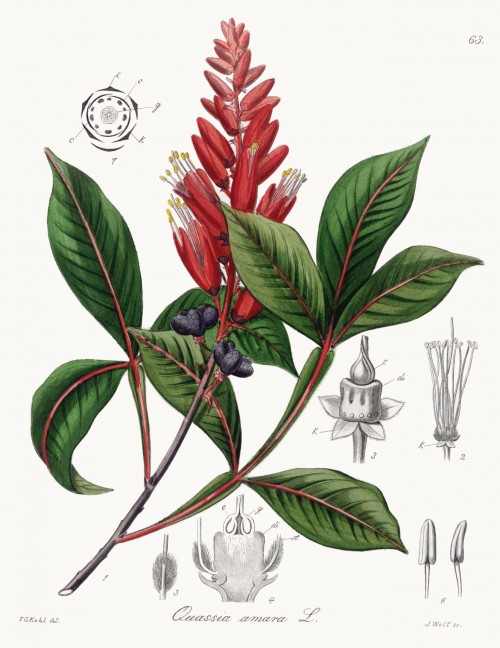Quassia amara L. - Simaroubaceae - amargo, bitter-wood, Surinam-Bitterholz
„It is a shrub or rarely a small tree, growing to 3 m tall … native to Costa Rica, Nicaragua, Panama, Brasil, Peru, Venezuela, Suriname, Colombia, Argentina, French Guiana and Guyana. Q. amara is widely planted outside its native range.“ http://en.wikipedia.org/wiki/Quassia_amara
Extracts of Quassia wood or bark act as a natural insecticide. http://oekologischerlandbau.jki.bund.de/index.php?menuid=52
„Extracts from the wood of Picrasma excelsa (Jamaica) and Quassia amara (Surinam quassia) are used as a bittering agent in the food industry. In addition, quassia wood is still used as an enema for threating threadworm or to thread lice and other parasites… Commercial quassin extract, representing approximately 0.2% of the dried wood, varies in ist constituents depending on the source but consists mainly of quassin (21-45%) and neoquassin (41%). The treshold bitterness of quassin is 0.06ppm which is 1670 times higher than caffeine, and therefore it is sometimes used as an alternative to quinine.“
[Quassia amara (Surinam Quassia): In Vitro Culture and the Production of Quassin, A. H. Scragg, E. J. Allan, Medicinal and Aromatic Plants VI, Biotechnology in Agriculture and Forestry Volume 26, 1994, 316-326]
„French Guiana (North-East Amazonia) records high malaria incidence rates. The traditional antimalarial remedy most widespread there is a simple tea made out from Quassia amara L. leaves (Simaroubaceae). This herbal tea displays an excellent antimalarial activity both in vitro and in vivo. A known quassinoid, simalikalactone D (SkD), was identified as the active compound, with an IC50 value of 10 nM against FcB1 Plasmodium falciparum chloroquine resistant strain in vitro. Lastly, it inhibits 50% of Plasmodium yoelii yoelii rodent malaria parasite at 3.7 mg/kg/day in vivo by oral route. These findings confirm the traditional use of this herbal tea.“
[Simalikalactone D is responsible for the antimalarial properties of an amazonian traditional remedy made with Quassia amara L. (Simaroubaceae), S. Bertani, E. Houël, D. Stien, L. Chevolot, V. Jullian, G. Garavito, G. Bourdy, E. Deharo, Journal of Ethnopharmacology, Vol.108 (1), 2006, 155–157]

Kohl, F.G., Die officinellen Pflanzen der Pharmacopoea Germanica, t.63 (1891-1895)
http://plantgenera.org/species.php?id_species=858161
